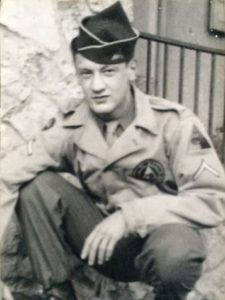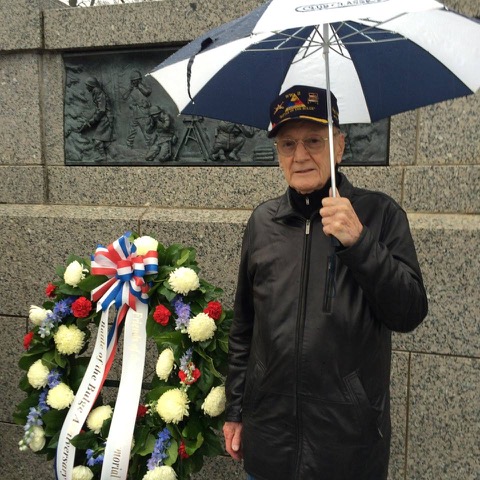
Harry F. Miller
Harry F. Miller was born in Ohio. He was one of three boys and three girls. His childhood was during the Great Depression, in which his mother died when he was three and his father later lost his job. To help make money for the family, Harry delivered newspapers. Harry had always wanted to join the U. S. Army, ever since he had watched local WWI veterans march in parades. He joined the Enlisted Reserve Corps when he was 15 (claiming he was 18). When he applied for active duty, Harry was assigned to Ft. Knox, Kentucky for Basic Training, then to Ft. Ord, California where he joined an amphibious tank unit.
During WWII, Harry served in the 740th Tank Battalion as a tank crewman. On Oct. 29, 1944, the battalion departed Weymouth, England and arrived at Utah Beach the next evening. Harry’s unit was sent to Belgium where they would get tanks so they could fight in the Battle of the Bulge. But most of the personnel had already fled, leaving dead bodies and worn-out equipment behind. After piecing together three M4 Sherman tanks and an M-36 Tank Destroyer, they were off to Stoumont, Belgium to attack the Germans. The battalion crossed the Siegfried Line moving to capture the south side of the city of Cologne. The last place they were sent to before the end of the war was occupying a castle on Lake Schwerin. Upon deactivation of the 740th, Harry was assigned to the 39th Infantry Regiment at Bad Tolz, Germany in the Regimental Message Center. Next, Harry was assigned to the police unit at HQ Troop, 2nd Constabulary Regiment at Freising, where he worked in the message center.
When the Korean War broke out, Harry headed MacArthur’s alert team, which went to Korea in advance of the general whenever he visited the battlefront. He came back to the States and was with the Army Security Agency in Arlington, Virginia. Then back to Germany with the communications intercept unit. Harry didn’t like this assignment and requested to go back to Korea, but was refused because of his security clearance. He knew too much to risk capture.
So after 10 years, he left the Army; went to the Air Force and asked if he could join. He entered with the same rank, technical sergeant and was assigned to Stewart AFB, New York. After serving in Alaska, back to Stewart and being assigned to U.S. Air Forces Europe, he was sent to SAC HQ at Offutt AFB, Nebraska, where with additional security clearances, Harry assisted in aircraft accident investigations of lost codes and cyphering equipment. When the Cuban Missile Crisis began, he was put on war status working 12- to 24- hours a day. When the Vietnam War started, Harry helped plan B-52 strikes, using special codes needed for Vietnam. Harry retired in 1966 with the rank of Senior Master Sergeant (SMSgt E8).
After leaving the service, Harry became a private investigator. Eight years later, he became the Director of Security and Safety for St. Vincent Hospital in Santa Fe, New Mexico. He also worked at the University of Texas at Arlington as a Safety Inspector, where he retired after 15 years.
Korean War - Key Events
September 15, 1950
X Corps, a force led by U.S. Maj. Gen. Edward M. Almond, stages an audacious amphibious landing at Inch’ŏn, some 150 miles behind enemy lines. The plan, conceived by UN commander Gen. Douglas MacArthur, is an unqualified success; 10 days later Seoul is liberated.
These events are taken from the Encyclopedia Britannica


Comments
Likes 1
You must be a registered user to comment or like - please register to join us!